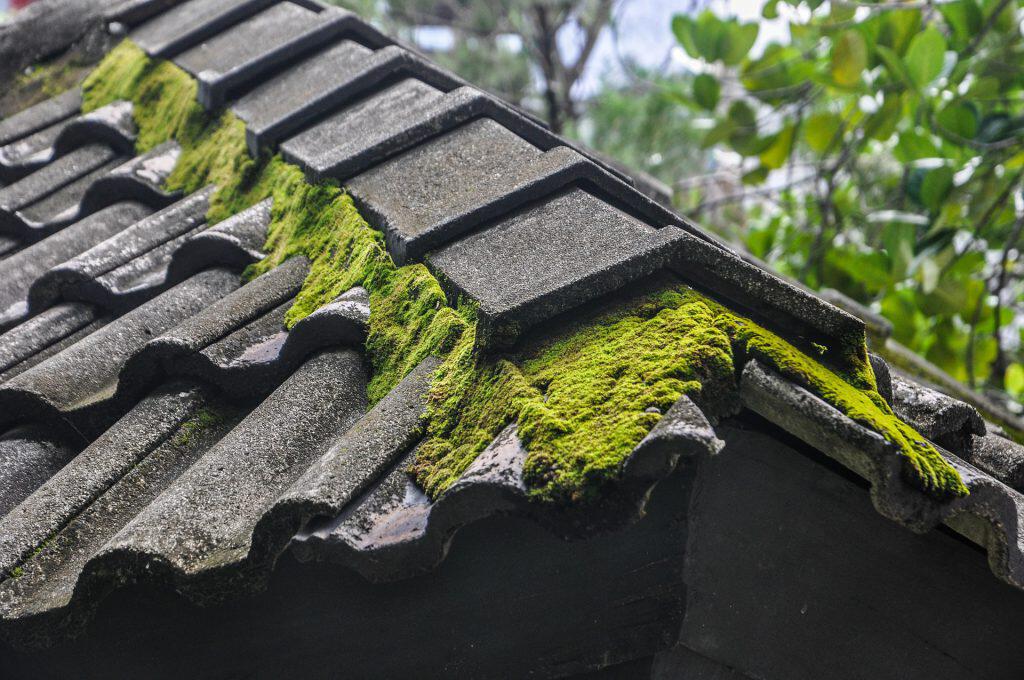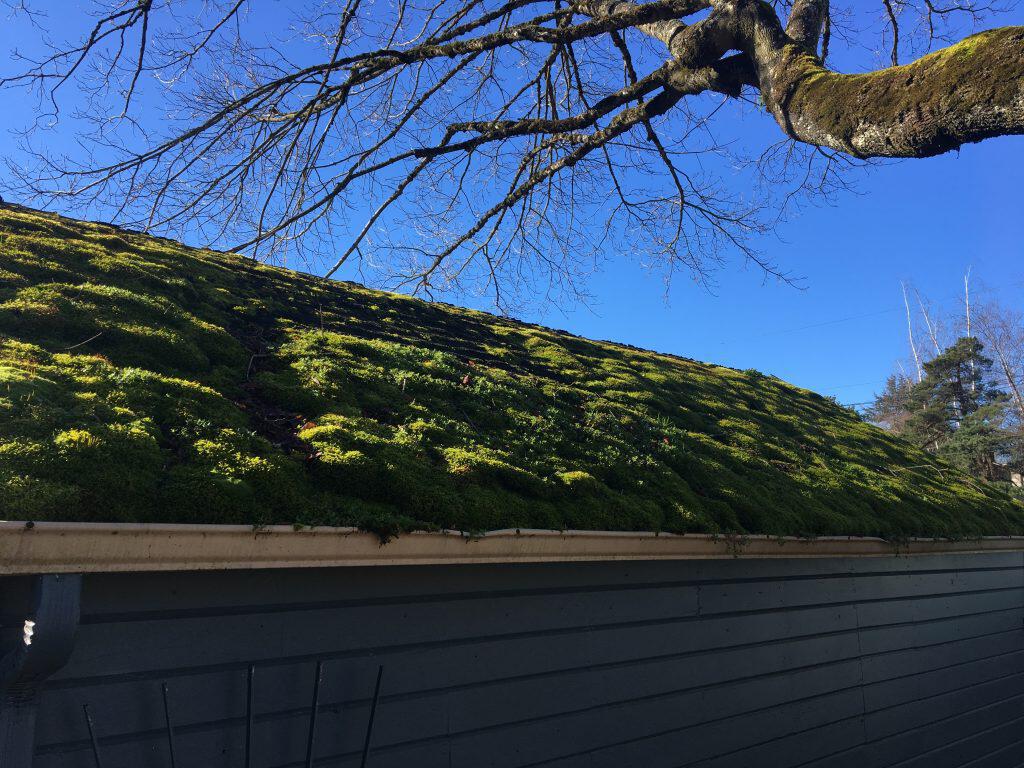When it comes to roof moss, it can become a cumbersome issue. In the Pacific Northwest, it is the foremost cause of roof leaks, shifting shingles, and ruining the overall look of your home. Some people have decided to take matters into their own hands with DIY solutions like laundry detergent. Before going into some DIY strategies, it is worth knowing just how moss growth occurs. This can give you an insight into how to best tackle roof moss. We decided to ask a Professional who broke down moss growth in four general steps.
- Dirt on the Roof
- It begins with layers of dirt that have settled atop your roof. Dirt’s texture also makes it easy for it to also build up small pockets of itself in the nooks and crannies of your shingles.
- Leaves & Dead Plants = Fertilizer
- Should dead leaves/plants settle on your roof and left there to combine with the dirt deposits, it creates the perfect breeding ground for growth to occur.
- Moisture (Humidity/Rain)
- The next step in the process is moisture. Humidity and rain sprout the growth of algae roots. (39 inches annually in Portland)
- Moss loves acidity. Portland rain is 5.4 ph.
- Over 70% of the roofs are of a darker shade, which stays warmer than the atmosphere. That provides incubation for moss to grow.
- “No Sunlight, No Problem” – Moss Growth
- While it is photosynthetic, moss only needs moisture to germinate and mature. Often times, their ideal environments are shaded areas.
*For over 37 years of moss removal, we know a thing or two about moss. For instance, did you know that there are three distinct types of moss that can grow on your roof?*
How to Use Laundry Detergent for Roof Moss

In the Pacific Northwest, the average rainfall averages a pH balance of 5.4, slightly acidic. Proper moss removal begins with offsetting the pH balance of your shingles and the moss itself. Laundry detergent is hypothesized to work best as its alkaline properties directly upset the pH of moss, which requires acidic rain. Here’s how most DIY and fixer-uppers go about putting laundry detergent on a mossy roof.
- Sprinkle powdered detergent on the affected area
- Let it settle
- Allow the rain to wash it off
- Clean the moss off with a scraper
You Shouldn’t Remove Roof Moss Yourself!
Fairly simple, right? Now a disclaimer. We here at Roof Life DO NOT recommend anyone do this. It presents more problems than one might think. For one, by tackling your moss problem, you’re required to go on a roof riddled with moss, which is quite literally, nature’s sponge. Without the right equipment, there remains a high risk of you slipping while on the roof. Losing your balance leads to serious injury to yourself and your roof. If the price is the main driver of your initiative to eliminate roof moss, we have some other variables for you to consider. For instance, the equipment you’ll need to ensure your safety.
Equipment cost
- Ladder (at least 20 ft) – $150
- Slip-Resistant Shoes – $40
- Laundry Detergent – $20-30
- Nylon Brush – $5
- Full Body Harness – $250 plus rope $100
- Garden Hose Pressure Regulator – $20
Total: $590
This is a rough approximation of the bare essentials for roof cleaning. Knowing that most people are not familiar with what is required for proper moss removal, we did not bother including the costs of specialized hose pressure regulators or the specialized chemicals that are designed to properly eliminate roof moss. Why? Because adding more variables would have priced this DIY solution the same as the average roof moss remediation. This also does not account for the amount of time it would take for you to manually set the ladder, sweep off debris, apply the detergent, wait for it to settle, rinse the roof, and brush off every little nook and cranny on your roof. The timing of Moss Removal is also very important. The perfect time to clean moss is usually just before fall rain. However, using laundry detergent instead of specialized chemicals to deep-clean your roof won’t do much. Instead, the moss will simply find its way back onto your roof.
What Laundry Detergent Really Does to Roof Moss
Top 3 Alternatives to Removing Roof Moss with Laundry Detergent
A Special Note to DIYers:

*If you’re adamant about using laundry detergent to help remove roof moss, we stress the importance of looking to the list of the bare essentials and obtaining all the necessary equipment. We here at Roof Life encourage further research as well. With over 37 years of experience, safety is of utmost importance to us. So please, practice caution and well-thought-out discretion before attempting to do this yourself.*
White Distilled Vinegar:
- Acidic Properties of White Distilled Vinegar has been shown to shock moss growth and other plants.
- Pros:
- Cheap and readily available.
- Cons:
- Not very effective with killing moss at its root level.
- Takes a few days for the vinegar to work against the moss.
- It requires a lot of scrubbing.
- Vinegar smell may linger.
Oregano/Oregano Oil
- Oregano has alkaline properties that can negate the acidic makeup of roof moss.
- Pros:
- Gets rid of moss pretty well.
- Buy Oregano from your local grocery stores.
- Cons:
- Oil is Expensive. Almost $400 for a 5lb bulk of oregano oil.
- Using Oregano flakes can take a long time for the moss to react.
- If you make the oil yourself, it may take a few days to make. The time you may not have.
- It can be very slippery and dangerous work if not very careful.
Dish Soap
- Dish soap contains alkaline materials that can be effective against moss growth.
- Pros:
- Effective at getting rid of moss.
- Cons:
- Very dangerous work. Laundry Soap can be very slippery and resistant to water-resistant shoes.
- The soap will melt the foundational asphalt lining beneath the shingle.
DIY vs Professional Cleaning: Costs
Break down of other commonly used DIY remedies
| Type of Cleaning | Pros | Cons | Cost | Total Approx. Cost (2000 sq. ft) |
| Pressure washing | Fairly quick process | Can damage roof (especially shingles) Doesn’t remove roots of moss or algae |
$0.15-$0.40 per square foot | $300-$800 |
| Low-pressure washing | GentleEffective and quick results | More expensive than harsh chemicals | $0.30-$0.50 per square foot | $600-$1,000 |
| Hose and nylon brush | Effective in removing dirt and deep stains | Labor intensive Expensive |
per square foot | $600-$1000 |
| Chlorine 2 bleach | Inexpensive and quick | Can corrode roof pieces and kill plants Harsh chemical |
$0.05-$0.25 per square foot | $100-$500 |
| Sodium hydroxide | Inexpensive and quick | Harsh chemicals Corrosive |
$0.15-$0.30 per square foot | $300-$1,000 |
| Pure lemon juice and salt | NaturalGentle chemicals | Slow to apply and clean | $0.01-$0.15 per square foot | $20-$300 |
| Vinegar (White Distilled) | NaturalGentle chemicals | Slow to apply and clean | $0.01-$0.15 per square foot | $20-$300 |
| Laundry Detergent | Inexpensive and quick | Slow to apply and clean Contains harmful chemicals |
$0.01-$0.15 per square foot | $20-$300 |
The table provided are rough estimates and may not be entirely accurate. It is meant to give you, the homeowner with a moss problem, an idea of how much you’d be spending for a simple moss cleaning procedure. This doesn’t account for the building materials, slip-resistant shoes, and other tools needed to properly rid roof moss.
Cost of Professional Roof Moss Removal
Most people pay an average of $1,500 for roof cleaning and treating, with a general range of about $1,000 to $2,000. This also is subject to change. Like most roof cleanings, there is no one-price-fits-all. There are many variables to consider before a definitive price is reached. If you are looking to have certified professionals come and take a look at your roof, feel free to call us for a free inspection! With Roof Life as your roofing specialists, you would also become a part of our Lifetime Workmanship Warranty program!